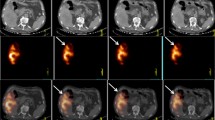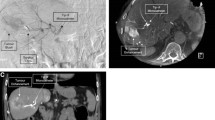Abstract
Purpose
Selective internal radiotherapy (SIRT) with the beta emitter yttrium-90 (Y90) is a rapidly developing therapy option for unresectable liver malignancies. Nontarget irradiation of the gallbladder is a complication of SIRT. Thus, we aimed to assess different strategies to avoid infusion of Y90 into the cystic artery (CA).
Methods
After hepatic digital subtraction angiography and administration of technetium-99m-labeled human serum albumin (99mTc-HSA), 295 patients with primary or secondary liver tumors underwent single-photon emission computed tomography/computed tomography (SPECT/CT). Different measures were taken before repeated Y90 mapping and SIRT to avoid unintended influx into the CA where necessary. Clinical symptoms, including pain, fever, or a positive Murphy sign, were assessed during patient follow-up.
Results
A significant 99mTc-HSA accumulation in the gallbladder wall (higher 99mTc-HSA uptake than in normal liver tissue) was seen in 20 patients. The following measures were taken to avoid unintended influx into the CA: temporary/permanent occlusion of the CA with gelfoam (n = 5)/microcoil (n = 1), induction of vasospasm with a microwire (n = 4), or altering catheter position (n = 10). Clinical signs of cholecystitis were observed in only one patient after temporary CA occlusion with gelfoam and were successfully treated by antibiotics. Cholecystectomy was not required for any patient.
Conclusion
It is important to identify possible nontarget irradiation of the gallbladder. The risk for radiation-induced cholecystitis can be easily minimized by temporary or permanent CA embolization, vasospasm induction, or altering the catheter position.






Similar content being viewed by others
Abbreviations
- 99mTc-HSA:
-
Technetium-99m-labeled human serum albumin
- CA:
-
Cystic artery
- CT:
-
Computed tomography
- DEB-TACE:
-
Drug-eluting bead TACE
- DSA:
-
Digital subtraction angiography
- GDA:
-
Gastroduodenal artery
- HCC:
-
Hepatocellular carcinoma
- RHA:
-
Right hepatic artery
- SIRT:
-
Selective internal radiation therapy
- SPECT:
-
Single-photon emission-computed tomography
- TACE:
-
Transarterial chemoembolization
- Y90:
-
Yttrium-90
References
Bester L, Meteling B, Pocock N et al (2012) Radioembolization versus standard care of hepatic metastases: comparative retrospective cohort study of survival outcomes and adverse events in salvage patients. J Vasc Interv Radiol 23:96–105
Bruix J, Raoul JL, Sherman M et al. Efficacy and safety of sorafenib in patients with advanced hepatocellular carcinoma: subanalyses of a phase III trial. J Hepatol (in press)
Coldwell DM, Hottenstein DW, Ricci JA et al (1985) Emphysematous cholecystitis as a complication of hepatic arterial embolization. Cardiovasc Interv Radiol 8:36–38
Cosin O, Bilbao JI, Alvarez S et al (2007) Right gastric artery embolization prior to treatment with yttrium-90 microspheres. Cardiovasc Interv Radiol 30:98–103
Crowder CD, Grabowski C, Inampudi S et al (2009) Selective internal radiation therapy–induced extrahepatic injury: an emerging cause of iatrogenic organ damage. Am J Surg Pathol 33:963–975
Geschwind JF, Salem R, Carr BI et al (2004) Yttrium-90 microspheres for the treatment of hepatocellular carcinoma. Gastroenterology 127(5 Suppl 1):S194–S205
Haydar AA, Wasan H, Wilson C et al (2010) (90)Y radioembolization: embolization of the gastroduodenal artery is not always appropriate. Cardiovasc Interv Radiol 33:1069–1071
Jiao LR, Szyszko T, Al-Nahhas A et al (2007) Clinical and imaging experience with yttrium-90 microspheres in the management of unresectable liver tumours. Eur J Surg Oncol 33:597–602
Komatsu T, Matsui O, Kadoya M et al (1999) Cystic artery origin of the segment V hepatic artery. Cardiovasc Interv Radiol 22:165–167
Kuroda C, Iwasaki M, Tanaka T et al (1983) Gallbladder infarction following hepatic transcatheter arterial embolization. Angiographic study. Radiology 149:85–89
Lance C, McLennan G, Obuchowski N et al (2011) Comparative analysis of the safety and efficacy of transcatheter arterial chemoembolization and yttrium-90 radioembolization in patients with unresectable hepatocellular carcinoma. J Vasc Interv Radiol 22:1697–1705
Lencioni R, Crocetti L (2012) Local-regional treatment of hepatocellular carcinoma. Radiology 262:43–58
Leonard JP, Siegel JA, Goldsmith SJ (2003) Comparative physical and pharmacologic characteristics of iodine-131 and yttrium-90: implications for radioimmunotherapy for patients with non-Hodgkin’s lymphoma. Cancer Invest 21:241–252
Lewandowski RJ, Sato KT, Atassi B et al (2007) Radioembolization with 90Y microspheres: angiographic and technical considerations. Cardiovasc Interv Radiol 30:571–592
Lewandowski RJ, Kulik LM, Riaz A et al (2009) A comparative analysis of transarterial downstaging for hepatocellular carcinoma: chemoembolization versus radioembolization. Am J Transplant 9:1920–1928
Lewandowski RJ, Geschwind JF, Liapi E et al (2011) Transcatheter intraarterial therapies: rationale and overview. Radiology 259:641–657
Martin R, Geller D, Espat J et al (2012) Safety and efficacy of trans arterial chemoembolization with drug-eluting beads in hepatocellular cancer: a systematic review. Hepatogastroenterology 59:255–260
McWilliams JP, Kee ST, Loh CT et al (2011) Prophylactic embolization of the cystic artery before radioembolization: feasibility, safety, and outcomes. Cardiovasc Interv Radiol 34:786–792
Memon K, Lewandowski RJ, Mulcahy MF et al. Radioembolization for neuroendocrine liver metastases: safety, imaging, and long-term outcomes. Int J Radiat Oncol Biol Phys (in press)
Miller FH, Keppke AL, Reddy D et al (2007) Response of liver metastases after treatment with yttrium-90 microspheres: role of size, necrosis, and PET. Am J Roentgenol 188:776–783
Murthy R, Brown DB, Salem R et al (2007) Gastrointestinal complications associated with hepatic arterial yttrium-90 microsphere therapy. J Vasc Interv Radiol 18:553–561
Ohta S, Nitta N, Sonoda A et al (2010) Embolization materials made of gelatin: comparison between Gelpart and Gelatin microspheres. Cardiovasc Interv Radiol 33:120–126
Paprottka PM, Hoffmann RT, Haug A et al (2012) Radioembolization of symptomatic, unresectable neuroendocrine hepatic metastases using yttrium-90 microspheres. Cardiovasc Intervent Radiol 35:334–342
Paprottka PM, Jakobs TF, Reiser MF et al (2012) Practical vascular anatomy in the preparation of radioembolization. Cardiovasc Interv Radiol 35:454–462
Pech M, Kraetsch A, Wieners G et al (2009) Embolization of the gastroduodenal artery before selective internal radiotherapy: a prospectively randomized trial comparing platinum-fibered microcoils with the amplatzer vascular plug II. Cardiovasc Interv Radiol 32:455–461
Polyzonis MB, Tsikaras P, Hytiroglou P et al (1989) Further observations on the vascular system of the gallbladder in man. Bull Assoc Anat (Nancy) 73:25–28
Salem R, Lewandowski RJ, Mulcahy MF et al (2010) Radioembolization for hepatocellular carcinoma using yttrium-90 microspheres: a comprehensive report of long-term outcomes. Gastroenterology 138:52–64
Sangro B, D’Avola D, Inarrairaegui M et al (2011) Transarterial therapies for hepatocellular carcinoma. Expert Opin Pharmacother 12:1057–1073
Shah RP, Brown KT, Sofocleous CT (2011) Arterially directed therapies for hepatocellular carcinoma. Am J Roentgenol 197:W590–W602
Sideras PA, Sofocleous CT, Brody LA et al (2012) Superselective internal radiation with yttrium-90 microspheres in the management of a chemorefractory testicular liver metastasis. Cardiovasc Interv Radiol 35:426–429
Takasaka I, Kawai N, Sato M et al (2010) A new soluble gelatin sponge for transcatheter hepatic arterial embolization. Cardiovasc Interv Radiol 33:1198–1204
Takayasu K, Moriyama N, Muramatsu Y et al (1985) Gallbladder infarction after hepatic artery embolization. Am J Roentgenol 144:135–138
Acknowledgments
The authors thank the WTZ Research Support Service (supported in part by the Deutsche Krebshilfe Comprehensive Cancer Center financing) for editing.
Conflict of Interest
The authors declare that they have no conflict of interest.
Author information
Authors and Affiliations
Corresponding author
Rights and permissions
About this article
Cite this article
Theysohn, J.M., Müller, S., Schlaak, J.F. et al. Selective Internal Radiotherapy (SIRT) of Hepatic Tumors: How to Deal with the Cystic Artery. Cardiovasc Intervent Radiol 36, 1015–1022 (2013). https://doi.org/10.1007/s00270-012-0474-1
Received:
Accepted:
Published:
Issue Date:
DOI: https://doi.org/10.1007/s00270-012-0474-1




